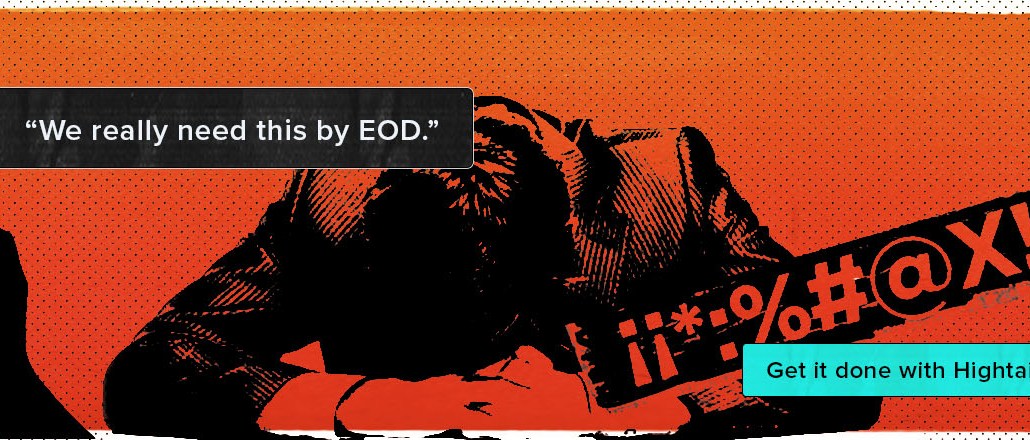Lost in translation: The journalist’s guide to agency speak

As industry gurus are fond of saying, everything is content.
Branded content shops are popping up everywhere to ensure that the web is in no short supply, and more and more journalists make the transition from fact-finders to “storytellers” everyday.
But once they’ve settled down at their new desks and start listening to the agency buzz around them, those journalists are likely to find their team speaking a totally different language than the one they’re used to.
Contemplating a switch from editorial to content marketing? Then read up on these common misunderstandings.
“You ready for the pitch tomorrow?”
What journalists hear: Were you able to cobble together a half-formed story idea for tomorrow?
What content marketers mean: An agency pitch is an entirely different beast (and man is it a beast): You have to nail an airtight concept that shows off a client’s brand in a new or inventive light, show how each piece of your campaign maps out across a variety of platforms and channels and bundle it all in a slick presentation. And that’s before the actual performance.
The real question: “How good are you on zero sleep?”
“Not sure that’s going to work for the client.”
What journalists hear: The advertiser might have concerns, but they’ll be cool with your journalistic objectivity. That’s why they hired you.
What content marketers mean: Things are a little different on this side of the tracks. Yes, you’re here to tell interesting stories, but those stories have to advance the objectives of the company that pays the bills. So your takedown of the public school system could work for the next piece — as long as you find a way to tie in Ticonderoga pencils.
“Have we gotten signoff from all the stakeholders?”
What journalists hear: This should be quick.
What content marketers mean: In a newsroom, there’s a quick hierarchy and the gears are oiled for speed. The reporter reports into the section editor, the section editor into the managing editor and the managing editor into the chief. Client-side, the approvals chain can be quick, or it can be long and winding, with everyone from the marketing manager to the vp, svp, evp, and CMO weighing in. The more people involved, the longer the process might be.
Make sure you understand the chain before you start your process, learn guardrails upfront and build their process into your project timeline.
“Where does this map to the buyer journey?”
What journalists hear: Is this going to be on a billboard? An in-store display? Where’s a consumer going to encounter the content on their way to a brick-and-mortar shop?
What content marketers mean: Brand messages reach consumers at a bunch of different points (and on a number of different platforms) from before they even know they need a new vacuum cleaner to their ultimate ecommerce checkout. If you’ve ever heard of the marketing funnel — which goes from awareness to conversion — you’re familiar with the path.
Which leads us to…
“This is cute, but does it lead to conversions?”
What journalists hear: Will this content change hearts and minds (and maybe save some souls from damnation along the way)?
What content marketers mean: Every road has an ending, and every piece of content is tied to a specific goal. Maybe that’s encouraging downloads of a new app, driving more site visits or directly selling more product. Consumers who take one of these actions have “converted.”.
Whatever its purpose, make sure your content performs through clear calls-to-action and sometimes-subtle positioning.
“Make sure you run it by the client’s PR team.”
What journalists hear: Run it by those people who used to hound you with press releases every hour.
What content marketers mean: PR people have a rough, thankless job. On the one hand, they need to get media outlets to cover their (often) less-newsworthy news. On the other hand, their heads are on the chopping block if any bad news leaks out, or if the brand gets tied to an unfavorable association. And maybe putting that guy who looks like the Unibomber on the homepage isn’t such a great idea, no matter how hot the mustache/sunglasses look is right now.
So do the right thing: Run your idea by PR.
“We’re aiming to leverage brand advocates for this campaign.”
What journalists hear: So now we have to get the brand’s legal team involved?
What content marketers mean: Instead of shelling out a bunch of cash for advertising, just tap into customers who already love the brand and get them to promote it for free. You’ll probably have to give them a reason them to do it. Try creating a branded hashtag for them to use across social media, or giving out prizes for the most-liked post about the brand.
Reward engagement and you’ll go far.
“We want to generate more engagement.”
What journalists hear: We want people to get excited about the story and start a conversation.
What content marketers mean: Metrics, metrics, metrics! The client wants to to see numbers: pageviews, scroll depth, scroll velocity, along with likes, comments, shares on social. You need quantifiable signs that audiences are investing more than a few seconds in your work.
If your content goes live and all it gets are a few page views, it didn’t really make a sound.
So there you have it: Creativity can be a messy, unfamiliar process. But with the right collaboration tools and enough gumption, everything comes together in the end to produce an awe-inspiring work of staggering genius — or at least effective content marketing that passes the approvals process.
More in Marketing

Google delays third-party cookie demise yet again
For now, Google seems to have next year in mind as the latest end date for its plan to eliminate third-party cookies.

WTF is the CMA — the Competition and Markets Authority
Why does the CMA’s opinion on Google’s Privacy Sandbox matter so much? Stick around to uncover why.

Marketing Briefing: How the ‘proliferation of boycotting’ has marketers working understand the real harm of brand blockades
While the reasons for the boycotts vary, there’s a recognition among marketers now that a brand boycott could happen regardless of their efforts – and for reasons outside of marketing and advertising – that will need to be dealt with.





